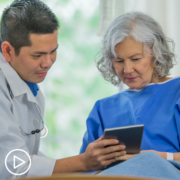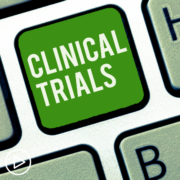How to Play an Active Role in Your Myeloma Treatment and Care Decisions from Patient Empowerment Network on Vimeo.
How can you actively participate in your myeloma care and treatment decisions? Engaging with your healthcare team is essential and may lead to better overall outcomes. In this program, Dr. Rafael Fonseca provides tips for how best to advocate for yourself or a loved one, as well as tools for making treatment and care decisions.
Dr. Rafael Fonseca is the interim director of Mayo Clinic Cancer Center and serves as the director for Innovation and Transformational Relationships at Mayo Clinic in Arizona. Learn more about Dr. Fonseca here.
See More From Engage Myeloma
Download Guide
Related Programs:
Transcript:
Katherine Banwell:
Hello and welcome. I’m Katherine Banwell, your host for today’s program. Today we’re going to explore how to engage with your healthcare team when diagnosed with myeloma, and we’ll discuss the patient’s role in care decisions. Before we get into the discussion, please remember that this program is not a substitute for seeking medical advice. Please refer to your healthcare team about what might be best for you. Let’s meet our guest today. Joining me is Dr. Rafael Fonseca. Dr. Fonseca, welcome, and would you please introduce yourself?
Dr. Rafael Fonseca:
Yes, of course. Happy to do that. Thank you very much, Katherine.
I am a hematologist/oncologist, but I specialize in the area of multiple myeloma. I work at the Mayo Clinic in Arizona. I currently serve also as interim executive director for the Mayo Clinic Cancer Center that is at large across the Mayo Clinic enterprise. But at heart, I’m a myeloma doctor and I love to take care of myeloma patients. I devote my research and the rest of my academic activities to the field of myeloma.
Katherine:
Excellent. Thank you so much for joining us today. Let’s start with a question that’s on the mind of many of our audience members. We’re hearing that the COVID-19 vaccine is safe, but how effective is it for myeloma patients?
Dr. Fonseca:
Thank you. I think that’s a fundamental question. It’s hard to know precisely how to gauge effectiveness when it comes to vaccination because historically, we know that is done by measuring antibodies and there’s a number of publications that are addressing this.
The concern has been two-fold. One is that because the disease itself is something that starts from the person’s immune cells become cancerous, that perhaps that would prevent them from having a very good response. Number two, and perhaps more importantly, will the treatments that are used for myeloma, etc. or lymphoma, can they interfere with our ability to mount an effective immune response? I think the response is mixed right now. I think I tell all my patients the upside is much better than the downside. I think we have a good record now of the safety of this product. I encourage everyone to get their vaccination.
I think it’s important to discuss this with your healthcare provider because sometimes people say, “Should I stop a little bit so that I can get a better response?” While it’s theoretically possible, we don’t want people to stop treatment if they don’t have to do that. Just my very last quick comment, the good news is that the community transmission is clearly going down as more and more people have participated in the vaccination.
We have more people who now have participated in this level of immunity that we have in the community. Hopefully, for patients as well as for their families, the risk of contracting this will continue to decrease.
Katherine:
Yeah. We can only hope. Well, let’s learn a little bit more about the disease itself. Dr. Fonseca, to level set with our audience, can you help us understand myeloma?
Dr. Fonseca:
I’m happy to do so. Multiple myeloma is a cancer form of the bone marrow that arises when the cells that under normal circumstances protect us by the formation of antibodies. These are called the plasma cells. They become malignant. Myeloma is the last stage of a process where a plasma cell can go through a benign tumor or benign phase, if you may, something we call the monoclonal gammopathy, which by the way is quite common. About two percent of people over the age of 50 have this abnormality. Think of it like the colon polyp, a precursor condition.
There’s an intermediate stage that we call smoldering multiple myeloma, which is just more growth, but not quite at the level that it creates problems for the individual.
Then lastly, what we just simply call multiple myeloma, and that is when the growth of those cells becomes of such magnitude that a person starts having problems or starts having symptoms related to that. These cells live predominantly inside the bones in the space we call the bone marrow. They can do a number of things that actually lead to the symptoms and to the clinical presentation. As they grow in the bone marrow, they take some of that real estate.
A person may experience fatigue and that is because they have anemia.
The myeloma cells are also very characteristic because they can erode into the structure of bones, so destruction of bone is another feature that we see in patients with myeloma. That can be either seen on x-rays or sometimes people will present with symptoms related to bone pain or discomfort with movement or weight bearing. Those are signs that we look for.
Lastly, the myeloma cells product proteins and some of the fragments of those proteins can be damaging to the kidneys. Occasionally, people will present with decreased kidney function and sometimes outright failure of the kidneys. Those are the common presentations. It is a disease that mostly affects people in their 70s. It is not something that you can detect through routine testing; it’s just indirectly we start seeing abnormalities and then we do the right testing. If anyone is hearing this, of course, they need to have a detailed discussion with their own provider.
Katherine:
Of course, yeah. When a person is diagnosed with myeloma, they usually have a whole healthcare team. Who is typically on that team?
Dr. Fonseca:
Absolutely. Let me start by saying the key to the successful management of myeloma is to have a well-organized team. It’s a disease that requires an integrated approach that usually brings around the patient a physician.
As part of my team, we also have advanced practice providers. We work with nurse practitioners that help us do the longitudinal care of patients. We have the nursing team. Every time I meet a new patient, I make it a point to bring my nursing team into the room so they can put a name and a face together, as patients will be interacting, of course, with a nursing team through the portal and the various visits. We have a team that is in charge of the chemotherapy administration. That is usually a separate a nursing team that is in charge of the administration of the medications. But we really don’t stop there.
We have pharmacists who help us review the medications for our patients. Very importantly, we have social workers that help us address psychosocial needs, as well as some of the practicalities that become inevitable when one deals with a serious diagnosis like multiple myeloma.
Katherine:
Yeah. Lately, we’ve been hearing this term, “shared decision making,” which basically means that patients and clinicians collaborate to make healthcare decisions, and it can help patients to take a more active role in their care.
I’d like to get your thoughts, Dr. Fonseca, on how best to make this process work.
Dr. Fonseca:
We are very fortunate to live in this time of medicine, where ultimately, we recognize that the patient is the person expert. It is the patient decisions that should drive what is to be done in a situation. Whenever I interact with patients, I tell them, “Listen, I’m going to be like your counselor. I will provide you with options of what I think is reasonable. I will go to different degrees of effort in trying to convince you one way or another for a particular intervention. But at the end of the day, I only do a good job if I present you with the options and the pros and cons of those various approaches.”
I weave that into my language on every single conversation we have with patients. I think we’re way past the time where a physician would come and say, “This is what you’re going to do,” or “This is what will happen.” My language always includes, “I would recommend this.”
“I think the next best step for you to consider would be X, Y, or Z.” But ultimately, I look at patients and not infrequently at the person next to them, a family member or a close friend, and I say, “You’re the boss and with the person next to you providing additional support, comment, and guidance, we can together reach the best decision of what should proceed.” I think we’re incredibly fortunate because patients have access to sophisticated information, especially patients that have serious conditions such as would be cancer and, in my case, myeloma.
As an example, when I work with general internal medicine residents that work with me learning about hematology, I sometimes tell them, “You’re gonna walk into a room. Are you gonna be seeing what I say, this is like a tennis match between professionals. Are you gonna see the level of questions that patients are going to be asking me? They’re going to be asking me about the latest study that was presented at this meeting and the P value and this and that.”
“I can guarantee you that you would not have the tools to be able to address all those questions, simply because there’s such an in-depth understanding of the disease.” I realize this is not everyone. I’m giving you an extreme example. There are individuals that need additional support, more resources. But just to interact with someone who has such commitment to understand their disease and to help us by that understanding make the right decision makes my job so much more rewarding.
Katherine:
What do you think is the role of a patient then in their care?
Dr. Fonseca:
I think it needs to be … I’m describing in some detail and there’s a lot to unpack there. Of course, patients are dealing with a very serious diagnosis. It’s okay to have periods where they are in a pause moment and they’re reflecting of what their facing, and that they can gather information from close family members.
I think we, as providers and the medical team, need to deliver a message that provides clear options for them as far as what the best next phase of their treatment or their management might be, including observations or supportive care. But the patient ultimately is a person who has to make that decision. I frequently get the question, and this is not surprising, and it happens all the time. A patient tells me, “What would you do if this was a family member?” I always tell them, “I always talk to you as if you were my family member, as if you were my brother, my mother, my father.
So, I try to live deeply to that fiduciary responsibility I have to your well-being. I recognize that there are circumstances, and that’s part of the finesse and the art of medicine, that I have to help a little bit more walk you through that step. Sometimes, it’s just human that one may want to say, I just want to disconnect. Maybe I’m not the person that wants to go and read in detail. But perhaps I have my daughter or my son who are helping me and understand better where things are.”
I think one of the key aspects of my role is to make sure that I have a sense that the person has a good understanding to be able to make an informed decision. At the end of it all, if the person decides to proceed in such way that doesn’t necessarily align with what I’m trying to do, I’m deeply respectful of that choice. I will go to extra lengths. So, if someone is foregoing treatment, when I know their treatment has a high likelihood of improving their quality of life, relieve a symptom, or improve survival, I don’t think I would do a good job if I don’t present why that’s so important. But ultimately, it is the patient’s decision.
Katherine:
Related to what you’ve just been speaking about, we have a question from the audience. This one is from Sarah. Her question is, “What advice do you have for caregivers? How can I be supportive during appointments?”
Dr. Fonseca:
That’s a great question.
I have experienced this both as a physician, as well as a caregiver myself to someone who has had a cancer. I think I’m gonna say that there are several roles that caregivers play. Some of them are obvious and I’m gonna call them practical or perhaps even pedestrian, you know, organizing the activities of every day. That’s important, but a lot of people can do that. The second role is to be in assistance for the knowledge that is needed for some of this decision making. Sometimes patients can be overwhelmed, and we need some support and some vetting and peer process from a trusted and loved person so you can go through that.
That is very helpful, but what is essential, and the number one thing is you are first and foremost the loving family member or friend of that individual who is living through a very profound human experience. I think the first role of a caregiver has to be to express that role.
I, myself, reflect on moments where perhaps in a quick, reactive way I wanted to solve some of the immediate practicalities and what was needed most was a direct support. Even if I face a situation today, if I was, again, a caregiver for someone with a serious diagnosis with cancer, I would start with that priority. Number one, you are the support and the loving person. Number two is I will try to provide information. And number three, hopefully you can help with meals and the driving and what have you. But there’s many more people who can come and help in that regard. Not a lot can do the first part.
Katherine:
Right, absolutely. Yeah, those are excellent points. Let’s talk about treatment goals. What are the goals of myeloma treatment from a clinical perspective?
Dr. Fonseca:
I’ve been very fortunate, also, to live through this era when we have seen a plethora of studies and new drugs being approved for the treatment of myeloma.
When I first started, I used to say no one wanted to do myeloma because we didn’t have good treatments. People wanted to study leukemia, lymphoma. It just turns out that this is probably one of the most vibrant areas of hematology from a science and from a clinical research perspective, of course. If I see young patients who have multiple myeloma, I have essentially two goals. The first one is to induce the deepest possible response I can do so in a safe manner. I also repeat, “in a safe manner.” But I really have the goal to try to induce the deepest response possible because that has translated and continues to translate, and in many ways proven to be associated with an improvement on their longevity and the time we can control the disease.
And it leads me to second goal, and that is that I firmly believe there is a subset of myeloma patients that are cured from their disease.
Now, this is possible because of the availability of these new treatments. I will only be able to say that in 10 and 15 years from now, when we have monitored patients for a long period of time, and we have been able to see that became true. But by all indicators, we have patients that are living many, many years without the disease coming back. I think that would be important. Now, we have patients that with more advanced age sometimes it’s difficult to propose some of the most intense form of treatments like stem-cell transplants.
We don’t do a lot of that in individuals over the age of 72 just because the toll that it takes on a person is very high, and the risks become higher. But still, in that population, providing the best treatment possible becomes a goal because I think more and more, we’re seeing patients in that age category that can start to get close to what normal life expectancy would be. It’s not there. It’s not perfect, but you start to get close. Lastly, if someone asked me, I have that balance between quantity and quality, the good news in myeloma, if you do it right, quantity and quality go hand in hand.
So, effective treatment provides symptom relief and provides durability of responses.
Katherine:
That’s excellent. What other factors do you consider when determining a treatment approach?
Dr. Fonseca:
The human experience that comes to the bedside as we consider treatments is so multi-factorial and multi-complex that all that needs to be brought into consideration. Whenever I walk into the room, I tell residents usually the medical part can be resolved pretty quick, but we’re reading how much we can communicate? What’s the level of understanding? What do I understand about the support system for this person? Is there someone who can drive to the treatment center? Is there someone perhaps whose other medical conditions would create certain challenges in how they’re gonna be treated?
This person is telling me they do daily hikes for four miles. Well, that’s different from someone who I see comes into the clinic and has to use a cane. We try to integrate all of that information to make the right decisions. I’ve made a lot of my career in the early years working and showing how, for instance, genetic factors are important. I’ve come to realize later in my career and through some of the very elegant work that other colleagues have done, that these factors are just as important in determining the ultimate outcome of patients. Whenever I talk about that clinical experience, there’s two things I always tell the residents.
I use the residents a lot because I think it’s a good example of how we aspire to interact with patients. Number one is every single encounter is a final exam. You have to put your best foot forward. Every single encounter should be considered a final exam. Number two is when I walk into that room, there are three things I do, particularly the first time I meet a person.
Number one is connect, right? We cannot have a conversation and I’m not gonna be able to move forward unless we have a human connection and I have gained the trust of the patient and the family members that are there. That’s number one. The second point is decide. That is usually okay, we’re gonna do this treatment or that. That is a small part. Most of the time for me, that’s a very small fraction of the time and of the mental energy that I consume. There’s cases that are more complicated, but most of the time it’s pretty straightforward. So, it’s connect, decide do very small, and then on the other end is explain.
So, that’s how I can connect. I propose we do this, and then why we are gonna do it and what can you expect. If you can do those three things, I think that goes a long way in establishing a fruitful and a productive relationship with a patient and their families.
Katherine:
I would suspect that you also take into consideration the patient’s health, their age, maybe test results, side effects, things like that?
Dr. Fonseca:
Of course. So, we look at the medical record and with the advent, of course, of the electronic record and all the tests that we do, our consideration is quite complex. We have to look at all those factors, and the age, and comorbidities. It’s rare that we would take one factor alone that would trump everything else. We usually have to integrate the information. The same is true when we manage myeloma patients and we’re monitoring their protein levels and their response to treatment. I tell patients, they ask me, “What would you do? What’s the magic number for this or that?”
I say, “It’s a little bit like you’re flying a Cessna plane and you have all these dials in your dashboard, and that’s how we manage the situation is the integration of all of that information.”
Katherine:
Right. Can you help us understand, Dr. Fonseca, how test results may affect treatment options?
Dr. Fonseca:
Sure. Happy to do that. In myeloma, we are very fortunate in that we have, and it’s not the topic for today, but we have the best biomarker that exists for any cancer. That is that we can measure the proteins that are associated with the growth of the cells. We have multiple tests that we can do. We do them in the blood and we do them in the urine. They’re simple tests that have been done for decades now that allow us to monitor how a person is doing with regards to their disease. I use the following analogy. Myeloma cells live inside the bones, as I mentioned, in the bone marrow.
They don’t come out into the blood. So, we cannot measure them. Indirectly, we can measure how many they are and how they are behaving by measuring this protein. I use an analogy of imagine you’re walking in a street, and you see smoke coming out of a building. There are two things you can do. First is you diagnose that there is a fire inside the building, right? We see that with myeloma by measuring these abnormal proteins.
Then as a firefighting team comes on, you can gauge whether they’re making progress or not by the amount of smoke that comes out. That’s exactly what we do when we monitor myeloma. We monitor the M-Spike, the serum free light chain, the urinary proteins. That’s how we make those determinations.
At the same time, we do that, we have to look indirectly at the rest of the body. We have to look at the kidney function. We have to look at the blood counts. We have to look at the hemoglobin and the red cell count because that can (A) start on the wrong foot because of the myeloma itself, but (B) can also suffer as a consequence of our treatment.
It is, again, that idea of having the multiple dials in the dashboard that allow us to reach our practice. We have to be adjusting. So, if we measure the proteins and we’re doing great, but then at the same time we see we’re suffering in blood counts, and we may need to adjust those as we provide supportive treatment. If we don’t see the proteins go down, then that may mean we need to change to a different form of treatment or that the person is unfortunately a refractory or relapsing to something.
So, that’s how we integrate the test results into our management.
Katherine:
What sort of questions should patients consider asking about their treatment plan?
Dr. Fonseca:
I think it’s important that patients understand a few things. They can be described in multiple ways. Number one is, of course, what? What is it that is being used? I think that includes a description of what to expect, the practicalities, the names of the medications, their side effect profile, and what to report when you use those medicines. I think that’s very important because if you’re empowered with that information, you’re gonna be better off as you react for symptoms that may come along. I always tell patients when you have a cancer diagnosis, your self-awareness goes through the roof because we’re gonna be paying attention to everything, every skin change, every pain we have.
So, I think having a bit of that proactive discussion becomes important as they think about the treatments that they want. I think the how-to on the practicalities are very important. The best where the nursing team and the pharmacists help us a lot too. Do you take the medicines at night? Do you take them with meals? Is there something that you shouldn’t be mixing? How much time would it take for me to get a refill? It’s different to get a medication from a specialty pharmacy versus your down-the-street Walgreens. So, all of those things are important that patients, again, participate in the understanding.
If not them, at least the caregivers that are a part of this team. I think it’s important that patients ask also some brief descriptions of (A) the biology of the disease. If I have myeloma, what type of myeloma do I have? Does that matter as far as what treatments I’m going to be using? What treatment options may be available to me because of my specific subtype? We have subsets of myeloma that have options that are not available to others.
Also, I think it’s important that patients also ask a sense from the physicians as to where they are. I’d like to describe this a little bit more. Sometimes, patients ask us specific questions about, am I in a complete response? Am I in a very good partial response? What is a PFS? Those terms work very well when we talk about clinical trials, but they don’t necessarily describe in a great way the situation for an individual patient. I’d use a lot more objectives than I’d use technical terms when I describe where patients are. I say, “You have an excellent response. You have a very deep response.”
Then I’d provide more details if they want. “Yes, you’re MRD-negative at 10 to the -6.” But sometimes I find that it’s harder for patients to understand where they are if they completely focus on the staging system or the response criteria, etc. Because maybe a VGPR, a very good partial response, doesn’t sound very good.
But then you can be in a very good partial response for 15 years and it doesn’t matter. You my want to be in an MRD-negative status, but you still have a good outcome. That’s why the general description of the status by a physician becomes important.
Katherine:
Do you think patients should get a second opinion consult with a specialist?
Dr. Fonseca:
In general, my answer is going to be yes. This is not self-serving. I think myeloma has become so complex that trying to integrate at least once, or if not, in some infrequent basis, an opinion of a myeloma specialist becomes important. This is no one’s fault. If you’re a community oncologist somewhere where myeloma represents only a small fraction of your practice, I can guarantee you, you cannot stay on top of the literature. I cannot stay up with everything that goes on with myeloma, even though that’s what I do 100% of the time.
I get an email every week with all the articles, all the publications, and I have to integrate that. I have to think, okay, does this matter or not? I go to the professional meetings. I see all the abstracts and I still feel like I’m missing out. How could you do that if that is only a small fraction of your practice? I’m sure that the same applies for other cancers, breast and colon. You can’t move. You cannot uproot yourself and leave your community and your family, but I think there should be ways by which patients at least have an opinion from someone who has more expertise. Fortunately, there are many centers across the nation now that have that expertise for the management of myeloma.
Katherine:
Dr. Fonseca, we have a question from a newly diagnosed myeloma patient. Barbara says, “I am just about to begin my first myeloma treatment. What can I expect?”
Dr. Fonseca:
Thank you, Barbara, for the question. I think if you start on treatment, first of all I hope they already went through a good description of what the treatments are, the frequency by which you’re gonna have to go to the center, and also what are the toxicities to look out for.
One of the most common toxicities that we face and one of the most challenging parts of initial treatment is the use of steroids. So, we use dexamethasone as part of every single regimen we use for myeloma. I tell patients, “Dexamethasone is a simple drug at first glance, but it’s oftentimes the most complicated part of treatment.”
The human brain works at triple speed when you’re on dexamethasone. So, it’s hard to sometimes be able to sleep properly. People can become anxious and even the sweetest person in the world can become a little bit edgy on dexamethasone.
I always say Mother Teresa on dexamethasone would be an edgy person. Just be patient. Work with the team. Just know that on the other side of treatment there is a return to normal life.
Our goal as we embark on treatments and, for instance, is I see patients that are going to go through transplant, I tell them, “Our goal is you finish, you recover, and you go back to your life. You back to work. You go back to your family, your kids, your sports.” That’s really what we strive for when we treat patients with myeloma.
Katherine:
Yeah. Once on therapy, how is the disease monitored and how do you know if the treatment is working?
Dr. Fonseca:
Well, fortunately, we use the same markers. Once a person is in therapy, we will be monitoring. We monitor at least on a monthly basis of those myeloma protein markers. Once a person reaches a great level of response, sometimes we complement that with an analysis of the bone marrow. Of course, it’s more invasive, so we don’t like to do a lot of them, but we do them as needed. As we go forward and monitor patients, we will be looking for signs that those proteins remain in a low level as stable as an indicator that the disease is under control.
Now, if I saw someone and then I start seeing that there’s an increased concentration of those proteins or we see something else clinical, we might need to do a little bit of a regrouping and test again in great detail to determine if the person is experiencing regrowth and the disease is so-called relapsed.
Katherine:
Why is it so important for patients to speak up when it comes to symptoms or treatment side effects?
Dr. Fonseca:
Well, that’s a great question. If you don’t speak about them, we don’t know about them. It seems very obvious, but then we cannot make the proper adjustments. I’ll give you a couple of examples. I already talked about dexamethasone, but a common drug we use is something called bortezomib. Bortezomib is a proteasome inhibitor.
That’s a mouthful, but it’s one of the key type of drugs we use. It’s given as an injection under the skin. Not to be confused, by the way, with daratumumab. Faspro is the name of that medication, so not to be confused with that is bortezomib, which we have been using for many years.
Bortezomib has a potential toxicity that is called peripheral neuropathy. If patients have peripheral neuropathy, that can go from very mild where you have some numbness and tingling, to the more extreme cases that it’s associated with pain, discomfort, even weakness and disability.
Well, if we don’t know that’s happening, then we can’t react to it and we can’t adjust doses or switch to something different altogether. You can imagine now we have more options, but in the old days, I always tell patients, “You might be tempted not to say anything about this because you might be thinking, boy, this is working. I don’t want to interfere with my treatment. I can live with the peripheral neuropathy.” But if it gets worse, despite the fact that the treatment is working, the person might have a very significant impingement on their quality of life.
More so now that we have so many alternatives, it’s important not to get us into a path that we might reach a point of an irreversible chronic complication from treatment.
Katherine:
No, and that would be awful.
Dr. Fonseca:
Absolutely.
Katherine:
Before we end the program, Dr. Fonseca, have there been any recent developments in myeloma treatment in research that make you hopeful?
Dr. Fonseca:
Absolutely. I would say that the one area of work that makes me most hopeful is what we’re seeing with immunotherapy. We have seen that both as the ASH meeting, as well as the ASCO meeting in this year, where people are presenting updates with the various clinical trials with either bi-specific antibodies or CAR T cell therapy as a new avenue for the treatment of myeloma.
In fact, at the last ASH meeting, we had 14 presentations of different compounds or different constructs that are active. I think the future is bright in that regard. We’re seeing their application right now. A lot of these updates have also been made as ASCO.
We’re seeing the update of the treatment of treatments with fairly advanced and aggressive disease where we can still show very significant responses. I participate in some of these trials. I can tell you in my institution, using some of the bi-specifics, I see patients who have previously exhausted all of their options and now are MRD negative at 10 to the -6.
If we’re seeing that in the very advanced disease, I cannot wait to see what happens when we start using these treatments in either early relapse and why not in the near future as frontline part of our therapy? I think to me, that whole field of T-cell engagers, where there’s bi-specifics or the CAR T cells remains one of the most exciting areas for future research.
Katherine:
How can patients stay up to date on information like this?
Dr. Fonseca:
I think what we alluded to before is very important to work with groups like yours and other patient support organizations that can keep them up to date. I think they’re doing a very good job at also providing updates post some of the large meetings. I know there’s a lot of patients out there that are very sophisticated that will even join the medical meetings. That happens with some frequency; that they want to learn, and patients that go and ask me details about the statistics of the trial. That’s a whole spectrum, right?
But at the minimum, I would say a strong connection with a support group, or a patient support organization becomes an imperative as you deal with this. Also, that would help you because with this whole concept of the information not always being complete and truthful, that can be scary as well, too.
If someone goes and just looks for, I would say even some of the resources that are out there in a textbook today, just keep in mind that textbook was probably written five years ago, and it represents the studies of about 10 or 15 years ago. How that relates to you, it’s very distant. So, it is because of this continuous process of research that we know better what’s going on at the present time.
Katherine:
Dr. Fonseca, thank you so much for taking the time to join us today.
Dr. Fonseca:
Oh, it’s my pleasure. Thank you for the opportunity.
Katherine:
And thank you to all of our partners. To learn more about myeloma, and to access tools to help you become a proactive patient, visit powerfulpatients.org. I’m Katherine Banwell. Thanks for joining us.






















